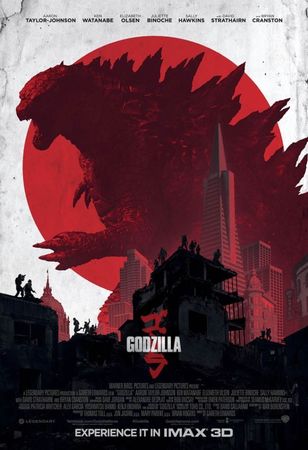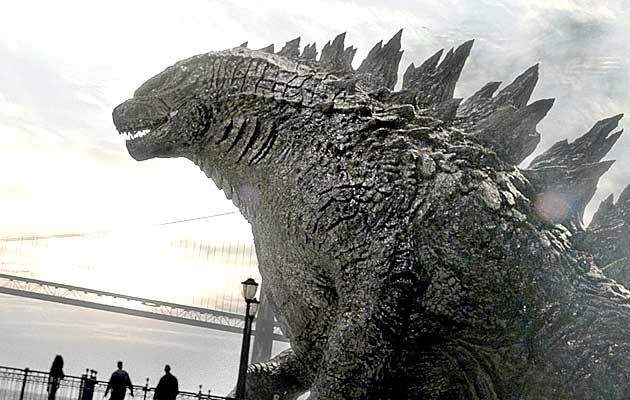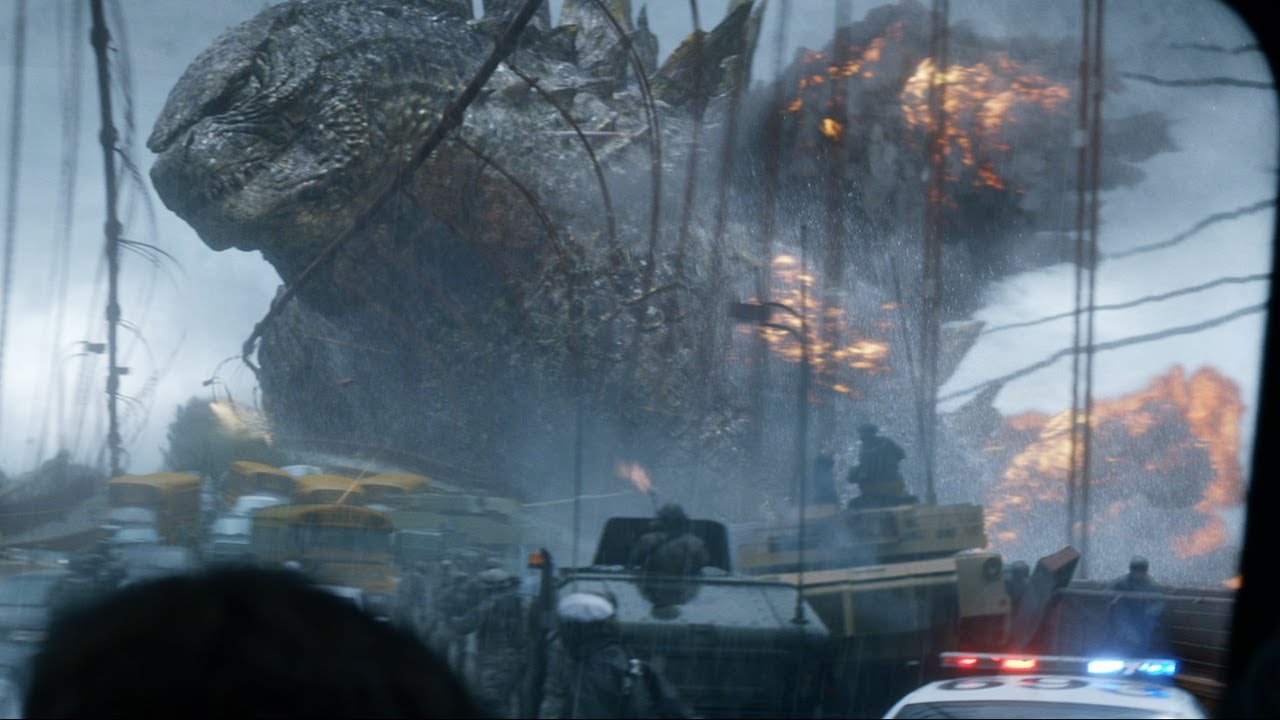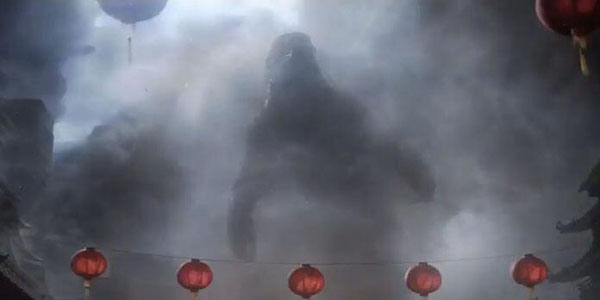Godzilla (2014) Is a True Godzilla Film and a Unique Blockbuster
 New to Godzilla? Read my 5-part history series.
New to Godzilla? Read my 5-part history series.
To all of those who saw the new Godzilla this last weekend who have never before fully understood the obsession fans have for this monster … now you will get it. Welcome to our weird world!
Godzilla isn’t just a massive monster that stomps stuff, confronts the military, and grapples with other monsters. Any giant beast can do that without much thought put into it. Godzilla is a character and a legacy. Even when playing the straight-up villain in films like 1964’s Mothra vs. Godzilla, the Big G is beyond larger than life and something you cannot help but gape at in awe and then salute. What a piece of work is a giant radioactive reptile! In apprehension how like a god(zilla)!
Director Gareth Edwards’s 2014 take on Godzilla, only the second film from a U.S. studio featuring the monster (or, if you ask most fans, the first), is a genuine Godzilla movie. Edwards’s creature isn’t the greatest incarnation to grace the silver screen, something I’m sure he would admit, as nothing could re-capture the cultural magic and hands-on effects work of director Ishiro Honda and special effects creator Eiji Tsubaraya from the classic series. But the Edwards Godzilla is a legitimate and superb version that achieves the gravity of the 1954 orignal Godzilla and the thrilling monster-vs.-monster mayhem of the films that followed it through three eras and six decades. For Godzilla fans, this movie contains the sheer ecstasy of a dream realized that brings spontaneous cheers, gasps of admiration, and watery-eyed moments of recognition. I could not imagine a better way to craft a U.S.-made Godzilla film, and it is to the immense credit of Edwards and everyone involved that, until now, I could not have foreseen how such a feat was even possible.
Even for those with scant knowledge of the great monster except what comes from the pop culture mill, Godzilla ‘14 is as an unusual Hollywood blockbuster. Gareth Edwards and Co. crafted a movie that stands apart from the stateside summer thrill machines as much as the Japanese films of 1960s did from their U.S. counterparts. Godzilla plays at the slow build, purposely restraining the sprawling spectacle until unleashing the finale. During the first two thirds, the suspense centers around scenes where the monsters remain glimpsed, their masses emphasized to drive the action without making them the centerpieces. Godzilla doesn’t receive a full reveal until an hour in, and the movie immediately leaps away after the unveiling. Instead of signaling the opening of the mayhem, the moment switches into the next step of the gradual climb to the plateau. Where many blockbusters pummel audiences with as much noise and pixels as they can afford until viewers feel only numbness for the finale, Godzilla wants to make them breathless in anticipation for the climax so that when it arrives, it means something.
Overuse has bled the word “awesome” of its original meaning, but Godzilla revitalizes it with its true sense. By taking a grounded visual approach to the monsters, doling them out one jaw-dropping piece at a time, Gareth Edwards elevates them into beasts of wonder. It’s no casual filmmaking choice that the first images on screen are early human representations of legendary creatures. The movie raises Godzilla and his two opponents into the realm where they are no longer simply big monsters, but the “strange beasts” meant by the Japanese word kaiju. How would it feel to us to actually see a 350-foot monster moving through a city? Terror mixed with a measure of humility and … awesomeness!
 Don’t let some of the myopic criticism directed at Godzilla ‘14 deceive you: the escalating pace of the monster action doesn’t mean the early parts of the film are dull or missing thrills. There are nail-biting sequences that Gareth Edwards slams home, such as a tidal wave hitting Honolulu due to Godzilla crashing ashore, and a military operation against a MUTO on a train trestle that’s as tight as suspense comes and has already drawn comparisons to the kitchen scene in Jurassic Park. The analogies between this film and classic Spielberg are not far off. When some of the dislike toward the film’s refusal to play for nothing but empty-calorie action dissolves away, Godzilla ’14 will probably be viewed as a watershed event, a picture that made brave and intelligent choices at every step and succeeded. It won’t come as a surprise if people remember the summer of 2014 principally for how Godzilla restored the sense of wonder to the exhausted blockbuster genre.
Don’t let some of the myopic criticism directed at Godzilla ‘14 deceive you: the escalating pace of the monster action doesn’t mean the early parts of the film are dull or missing thrills. There are nail-biting sequences that Gareth Edwards slams home, such as a tidal wave hitting Honolulu due to Godzilla crashing ashore, and a military operation against a MUTO on a train trestle that’s as tight as suspense comes and has already drawn comparisons to the kitchen scene in Jurassic Park. The analogies between this film and classic Spielberg are not far off. When some of the dislike toward the film’s refusal to play for nothing but empty-calorie action dissolves away, Godzilla ’14 will probably be viewed as a watershed event, a picture that made brave and intelligent choices at every step and succeeded. It won’t come as a surprise if people remember the summer of 2014 principally for how Godzilla restored the sense of wonder to the exhausted blockbuster genre.
And we haven’t even arrived at the film’s best part: the climax that now sets the bar for excitement for the rest of the year. The last half hour transforms into a VFX spectacular that stuns in how it portrays the monsters as if they were traditional effects work. Imagine if Toho effects wizard Eiji Tsubaraya came back to life armed with a computer and got suitmation actor Haruo Nakajima (who portrayed Godzilla from 1954 to 1973) to mo-cap the monster. I’m unsure how it is possible for CGI to look this way, but the combination of giant monsters grappling each other in a classic effects style mixed with a Gustav Doré setting of a debris-choked sky is the stuff of dreams; I’ve never seen effects like it and yet it has beautiful familiarity.
As you may have picked up from hints in the trailers and the buzz around the film, Godzilla is the hero. Not just because the humans — both viewers and those in the movie’s universe — want Godzilla to triumph over the two insectoid MUTOs for the fate of San Francisco, but because Godzilla really is the main character. Godzilla’s portrayal has a similar nuance and subtlety to other praised CGI-generated characters like Gollum from The Lord of the Rings series and Caesar from The Rise of the Planet of the Apes. At points, Godzilla is enraged, at other times exhausted and annoyed, blowing out a peeved sigh in the middle of the wreckage of San Francisco as if to say, “These damn bugs, huh? Need to get back in shape.” This is a monster you understand and love, even as your world crashes down around it.
 The MUTOs, the spindly beasts who emerge from their chrysalises to feed on human-made radioactive sources, also receive a great deal of personality and aren’t relegated to fight-fodder for the end. As with many great Toho monster opponents, the MUTOs have a reason to exist beyond just supplying Godzilla with a target. They set events in motion, dominate the first half, and their aggression to reach radioactive sources and eventually each other comes from a place far distant from human concerns. We want to see Godzilla triumph over the MUTOs in the conclusion because they have already caused more destruction with the potential to create worse, while Godzilla just wants to trounce them and go home. But the MUTOs are impossible to completely hate, especially when they receive a few moments that are actually touching.
The MUTOs, the spindly beasts who emerge from their chrysalises to feed on human-made radioactive sources, also receive a great deal of personality and aren’t relegated to fight-fodder for the end. As with many great Toho monster opponents, the MUTOs have a reason to exist beyond just supplying Godzilla with a target. They set events in motion, dominate the first half, and their aggression to reach radioactive sources and eventually each other comes from a place far distant from human concerns. We want to see Godzilla triumph over the MUTOs in the conclusion because they have already caused more destruction with the potential to create worse, while Godzilla just wants to trounce them and go home. But the MUTOs are impossible to completely hate, especially when they receive a few moments that are actually touching.
When Godzilla and the MUTOs hurl into the Battle of the Bay for the climax, the hero of the story explodes into majesty that will tear cheers out of almost any audience and destroy most G-fans. One of the biggest moments is one that anybody familiar with Godzilla knows is coming … but the realization that the movie is actually about to go there is one of the greatest pleasures I’ve experienced during a summer blockbuster. (My opening night audience flew into absolute hysterics when it happened.) And even this isn’t the finishing note that everyone will come out of the theater talking about.
You may have noticed that I’ve so far made no mention of the characters played by humans. The movie does have them, and … they’re fine. No more or less intriguing than the majority of human characters from many of the Toho classics, which frequently had low-key leads and gave the more intriguing roles to supporting parts and the occasional villain. The characters benefit from good performances, especially David Strathairn as the stoic military official. Strathairn can do this sort of authority without stretching, but that gives a pleasant “studio system” feel to the character, and the part is refreshingly void of the cliché of the gun-happy military moron we often see in spectacle movies.
The humans hold down a terse first thirty minutes, and then gradually ease back as the scope broadens and the true leads step up to the plate … and this is just as it should be. It would be far worse to have bloated attempts at “colorful” Hollywood stereotypes, such as those in any Michael Bay flick or the grating 1998 Godzilla, who end up either plot-driven idiots or pure annoyances.
 The human lead, Lt. Ford Brody (Aaron Taylor-Johnson), comes across as a bit of a blank. He works best across from his father (Bryan Cranston in fine manic form) and then as Godzilla’s buddy cop partner during the conclusion. No, I’m not making that up. It’s another remarkable aspect of the finale. Even though we cut between the Godzilla vs. The MUTOs fight and a military mission to reach a nuclear warhead in the middle of San Francisco, the movie manages to meld the two through the suggestion that Ford and Godzilla are aiding each other. Godzilla doesn’t know Ford, of course — Godzilla cares nothing for any puny human — but the magic happens through the editing and structure of the sequence. This undercuts any complaints I have about Ford as a character or Taylor-Johnson’s performance; both of them work in the film as a larger whole. The story makes us know that Godzilla is the true hero and lead. The other characters exist to build up the Big G, and they handle this job admirably.
The human lead, Lt. Ford Brody (Aaron Taylor-Johnson), comes across as a bit of a blank. He works best across from his father (Bryan Cranston in fine manic form) and then as Godzilla’s buddy cop partner during the conclusion. No, I’m not making that up. It’s another remarkable aspect of the finale. Even though we cut between the Godzilla vs. The MUTOs fight and a military mission to reach a nuclear warhead in the middle of San Francisco, the movie manages to meld the two through the suggestion that Ford and Godzilla are aiding each other. Godzilla doesn’t know Ford, of course — Godzilla cares nothing for any puny human — but the magic happens through the editing and structure of the sequence. This undercuts any complaints I have about Ford as a character or Taylor-Johnson’s performance; both of them work in the film as a larger whole. The story makes us know that Godzilla is the true hero and lead. The other characters exist to build up the Big G, and they handle this job admirably.
Godzilla ‘14 doesn’t engage in an overtly explicit theme, certainly nothing near Godzilla ‘54 or even some of the Heisei movies. The ideas exist, but the characters don’t participate in much discussion about them aside from Dr. Serizawa (Ken Watanabe), who reveals a personal connection to Hiroshima in an understated and effective scene. At its core, this is a “balance of nature” tale, in which Godzilla represents a violent swinging of the pendulum back toward order against a disturbance. “If you humans are going to wake up a primordial conflict from 70 million years ago, you have to expect collateral damage and violent heroics before it all gets sorted out.”
In this essay, David Ehrlich calls Godzilla ‘14 the first “post-human blockbuster,” in which all human action is futile or fatal, and the creatures rule all even in scenes where they aren’t present. But the sense of the film is not the grim and hopeless display that Ehrlich implies, for this is no Lovecraftian plunge into human despair looking into the void. The mere mortals of Godzilla, along with the viewers, are invited to stare up at the inhuman majesty and whisper: “Thank you.”
As Godzilla ’14 closes, it breathes life with a beautiful moment where people revel in astonishment. Fearsome and terrifying as this giant monster appears, what a marvel that it exists! And what a marvel that blockbuster films, even in the Era of Glut and Excess, can still seize onto that sense of primal wonder.
…and, thanks to a phenomenal opening weekend take of $93.2 million in the U.S. and an additional $103 million international, it’s also a new beginning. Although Godzilla ‘14 tells a complete story, it feels like the start of a fourth series — the Legendary Era —t hat could stretch on for ten more films and fly off in astonishing directions that include alien invasions, three-headed space dragons, and fighting robo-replicas. (My speculations about sequel monsters.)
Quoth Dr. Praetorius: “To a new world of Godzillas and Monsters!”
Ryan Harvey is one of the original bloggers for Black Gate, starting in 2008. He received the Writers of the Future Award for his short story “An Acolyte of Black Spires,” and his stories “The Sorrowless Thief” and “Stand at Dubun-Geb” are available in Black Gate online fiction. A further Ahn-Tarqa adventure, “Farewell to Tyrn”, is currently available as an e-book. Ryan lives in Costa Mesa, California where he works as a professional writer for a marketing company. Occasionally, people ask him to talk about Edgar Rice Burroughs or Godzilla in interviews.
They had (of course) a trailer for the new Transformers movie before Godzilla, and it only helped to cement how profoundly wrong Michael Bay gets _everything_.
Yeah, there couldn’t be a more anti-Michael Bay film. Godzilla is even more a reaction to the Transformers films than it is to the 1998 Godzilla.
It is a hit in my classroom. Every student who went talks excitedly about it. I’m going this weekend.
Ape, that’s great news. If it’s got the young folks, then we’ve won.
Ryan,
My wife and I just saw Godzilla last night. It was excellent. I loved that it covered Japan and the U.S. And I loved the role of Godzilla as the great equalizer. I liked when one of the characters suggests, “Let them fight.” (Or something to that effect.)
But even with Godzilla not directly attacking humanity, he’s still the cause of great damage, and watching that extreme carnage on the big screen in 3-D was amazing. (I’m not a fan of 3-D but it was a spur-of-the-moment decision to turn our date night into a double feature, having already seen X-Men – also a great movie.)
I know this article is off the main page at BG now, but I wanted to say that I love your series of articles around Godzilla, and your praise for the latest movie was one of the reasons I wanted to see it in theatres.
Matt, thanks! I’m glad to hear it, these articles have meant a lot to me personally.
I just got back from watching it in IMAX 3D. The 3D wasn’t much for me, but the spectacle on a 60′ screen (it’s a genuine IMAX screen, one of only 5 in L.A. and Orange Counties) was astonishing. And the film reveals so many extra layers on a second viewing.
[…] his review of the American re-launch of the venerable franchise, which you can (and should) read HERE. I’m not going to retread what he has covered, but I think the return of the King of Monsters is […]
[…] Godzilla (2014) Is a True Godzilla Film and a Unique Blockbuster […]